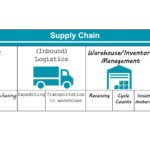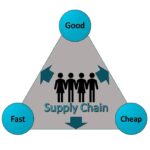Several months ago, I published an article on what makes a utility supply chain unique. This article is the same for the manufacturing supply chain – which is a HUGE category with thousands of businesses represented. I’ve been working in and with manufacturers since my first internship with Caterpillar *cough*InTheEarly2000s*cough* and have always found joy in being part of making things. Manufacturing supply chains are all about throughput, so let’s explore the differences a little further.
Speed and Volume
On the Iron Triangle of cost, quality and lead time, manufacturers often (but not always) prioritize lead time higher than cost and quality. Manufacturing supply chains heavily emphasize speed and volume, especially for materials directly used for manufacturing products. I don’t remember a manufacturing team I was involved in that didn’t talk about “sense of urgency” in relation to serving internal customers and keeping the line running. Keeping the line up is such a high priority that manufacturers will purchase commercial airline seats for boxes of parts, where they will strap that box of parts into the seat beside the technician responsible for bringing those parts back to the line.
Story time: When I first started working for a utility, I received a phone call from an internal customer on a Tuesday morning. He needed a part and told me it was urgent. So I did what I did in my manufacturing supply chain role – I started calling around to suppliers to find the needed part. I located one and told the sales rep to have it packaged on a pallet, I would call him back about how we wanted him to ship the part. I called the customer back and told him, “I found the part about a two-hour drive away. Do you want to go pick it up, or do you want me to overnight it?” Confused, he answered, “Getting it here Thursday would be fine.” That was the moment I realized how different “urgent” was in the manufacturing world I came from compared to the utility world. In the manufacturing world, an engineering technician would have already been an hour’s drive down the road in the direction of the supplier most likely to have the part on hand.
Risk Tolerance
While most industries have a higher risk tolerance than utilities, manufacturers tend to be a bit higher on the risk tolerance spectrum. Smaller manufacturers especially are willing to work without contracts, run extra lean on materials due to cash flow and part availability, and calculate the Return on Investment for any large purchase. This risk tolerance makes manufacturers more flexible, able to pivot quickly, and also able to capture the rewards when risks pay off. The smaller the manufacturer, the more flexible they tend to be as they do not have as much large equipment that only does one task. (Geeky side note: when I think of custom equipment that only does one thing, I always think of Alton Brown and his extreme dislike of “unitaskers”). With limited resources, smaller manufacturers tend to invest in more versatile equipment so they can respond to market shifts and stay competitive.
Direct and Indirect
While it’s common for supply chain teams to focus more on materials than services, that is especially true in manufacturing. With the exception of plant services (also called maintenance services or MRO), most of the focus in a manufacturing supply chain is keeping the flow of direct materials moving. The supply chain team can typically go out to the shop floor to see purchased items and how they are used, pick them up (if they aren’t too heavy), and understand when a supplier sent a material that doesn’t meet specification. The focus on materials is also why most manufacturing supply chain teams are divided by Direct (purchasing goods and services that go directly into the final manufactured product) and Indirect (goods and services that support the manufacturing process, but do not end up in the final product) instead of organizing by Materials and Services.
Continuous Improvement
Manufacturing supply chains also tend to be engaged in structured continuous improvement programs such as Lean Manufacturing, SixSigma, Kaizen, The Toyota Way, or some other variation. In large manufacturers such as John Deere, they may run their own custom continuous improvement program with edits and tweaks to suit their structure and customer. If you’ve found yourself in a manufacturing supply chain, take advantage of any continuous improvement program the company has and learn as much as possible. It’s always been valuable to me to have learned early how to think about constantly improving my job. Contrary to the “Job security” phrase so common in corporate America, I’ve always found the best way to get promoted was to minimize or even eliminate my previous job so my leadership team viewed me as “freed up” for the next position. Now that I’m working with multiple companies, I’ve used that continuous improvement training to run mini-Kaizen events both inside and outside the supply chain processes and found great opportunities to minimize the tedious part of tasks.
Little Fish, Big Pond
The last thing that makes a manufacturing supply chain unique is the “little fish in a big pond” nature of the business. There were almost 600,000 manufacturing businesses in the US alone in 2021, and far more in other parts of the world. While of course not all of these businesses use the same suppliers or serve the same customers, there is definitely overlap and competition is fierce. Manufacturers are little fish in a large pond, and that same source cites that over 90% of US factories employ fewer than 100 people. Less than 0.2% employ more than 1000 people. That means most of those companies have very little leverage in their market. Unless you’re part of a supply chain team for those 0.2%, you’re probably negotiating small volumes with suppliers. That lack of leverage makes supplier relationships very important, especially when coupled with the sense of urgency needed to keep manufacturing lines running. This also means procurement teams negotiating purchases for manufacturers are likely serving in multiple supply chain roles at once (procurement, logistics, purchasing) and need to use multiple negotiation tools to build and capture value for their business.
The sense of urgency, risk tolerance, focus on direct materials, continuous improvement mindset, and abundant competition shape the manufacturing supply chain worldview. As a practitioner, understanding these differences can help you shape your career and be successful within your chosen industry. If you’d like to talk further about the nuances in your own manufacturing supply chain, let’s chat.




